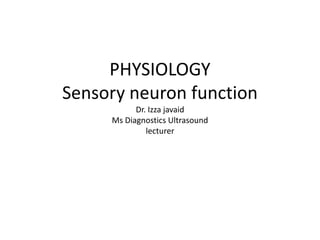
Sensory system and somatic sensation.pptx
- 1. PHYSIOLOGY Sensory neuron function Dr. Izza javaid Ms Diagnostics Ultrasound lecturer
- 2. Objectives 1.Sensory Receptors, Neuronal Circuits for Processing Information 2.Somatic Sensations: General Organization, the Tactile and Position Pain and Thermal Sensations
- 4. Afferent division of the nervous System Receptors Sensory neurons Sensory pathways
- 13. Receptors adaptation The duration of a stimulus is coded by duration of action potentials. A longer stimulus generates longer series of APs. If a stimulus persists, some receptors adapt or stop responding There are 2 classes of receptors according to how they adapt: Tonic receptors – slowly adapting – they fire rapidly when first activated, then they slow and maintain firing as long as the stimulus is present (baroreceptors, proprioceptors) Phasic receptors – rapidly adapting receptors – rapidly firing when first activated but stop firing if the strength of stimulus remains constant This type of reaction allows the body to ignore information that was evaluated and found not to be a threat to homeostasis (smell)
- 14. Sensory receptors properties • Sensory transduction convert stimulus energy into nerve energy (action potential) • Receptor potential (excitable tissue) • Adaptation (high and low ) conscious sensation declines with continued stimulation
- 16. Processing at the Receptor Level The receptor must have specificity for the stimulus energy The receptor’s receptive field must be stimulated The stimulus need to be converted to a nerve impulse Receptors have different levels of adaptation Information is encoded in the frequency of the stimuli – the greater the frequency, the stronger is the stimulus.
- 17. The somatic sensory system Sensory stimuli that reach the conscious level of perception Specialized cells that monitor specific conditions in the body or external environment General Senses: Temp, pain, touch, pressure, vibration, proprioception Simple receptors located anywhere on body Special Senses: Are located in sense organs such as the eye or ear Olfaction, vision, gustation, hearing, equilibrium Complex receptors located in specialized sense organs
- 18. 1 2 3 Receptor level (sensory reception and transmission to CNS) Circuit level (processing in ascending pathways) Spinal cord Cerebellum Reticular formation Pons Muscle spindle Joint kinesthetic receptor Free nerve endings (pain, cold, warmth) Medulla Perceptual level (processing in cortical sensory centers) Motor cortex Somatosensory cortex Thalamus Processing of the sensory information
- 19. Association Motor Sensory Sensory area for impulses from eyes
- 20. cerebrum/cerebral hemispheres •Sensory areas of the cerebral hemispheres receive impulses from sense organs and transmit them to the association areas •The association areas of the cerebral hemispheres receive impulses - interpret them in the light of similar past experiences and transmit impulses to motor areas •The motor areas transmit impulses to the effectors •The size of the sensory and motor areas is related to the number of receptors in that area •The left and right cerebral hemispheres control the opposite sides of the body
- 21. Mapping of the sensory & motor areas to the body shoulder w r i s t h a n d f i n g e r s t h u m b eye face lips jaw tongue s w a l l o w i n g c h e w i n g legs toes n e c k e l b o w t r u n k ankle hip Motor Cortex shoulder w r i s t f o r e a r m h a n d f i n g e r s t h u m b eye face nose lips gums jaw tongue p h a r y n x a b d o m e n legs toes genitalia e l b o w t r u n k foot hip Sensory Cortex
Editor's Notes
- The association of one sensory modality with one type of nerve fiber is the basis for the labeled line theory (Frequency coding principle, Concept of specific nerve energy, and Labeled line principle)
- The size of the representation of various body parts in the primary somatosensory cortex is correlated with the density of cutaneous receptors in that body part